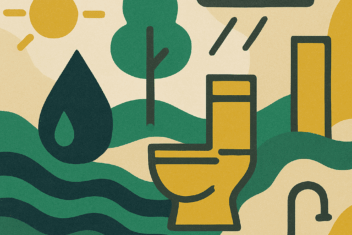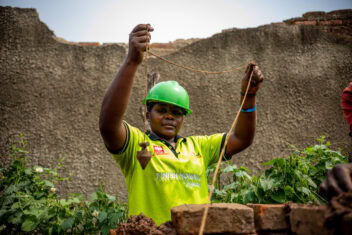Saving Lake Victoria | A Journey Toward Sustainable Sanitation Solutions

By Sumeet Pawar, Climate Change and Circular Economy Expert
Just a few years ago if you were to visit the districts of Magu and Misungwi, which sit on the edge of the beautiful Lake Victoria in the Mwanza region of Tanzania, you would see a dire sanitation situation threatening the precious waters and the livelihoods which depend on it. Lake Victoria, the world’s largest tropical lake and a lifeline for over 40 million people across East Africa, was drowning in pollution, largely due to tonnes of untreated faecal sludge which permeate its water each year. Today, however, there is hope with people from across all levels of the community showing that sustainable change is possible.
Magu and Misungwi districts are just two examples of communities facing these kinds of issues. In 2022 WASTE, through the EU-Water Operated Partnership (WOP) Programme, delved deeper into understanding their situation. We chose to conduct an informative Shit Flow Diagram (SFD) study to better understand the flow of sanitation services and identify gaps in their faecal sludge management system. The SFD study revealed that an alarming 80% of faecal sludge in these areas was not safely managed (see Magu SFD below). This was having disastrous consequences, not just for the lake, but for the people who depend on its water for agriculture, fishing, and drinking water.

To change this dramatic reality, in 2023 we worked with regional water authority, MWAUWASA, and other key stakeholders to review the SFD findings and develop a plan to address faecal sludge emptying challenges. This included local MWAUWASA teams from Tanzania taking part in an exposure visit with water utilities in Nakuru and Kisumu, Kenya to explore innovative pit emptying technology and operational models.
Fast forward to this year and in September 2024 we introduced a new innovative solution in Magu and Misungwi – cue the PuPu pump – a tool designed to address the critical issue of pit latrines and toilets that cannot be serviced by conventional vacuum trucks. During this visit, we had the opportunity to witness firsthand the impact of our interventions as we demonstrated the PuPu pump and trained local MWAUWASA team members and formal and informal (frogmen) pit emptiers.

It was a transformative moment when we successfully emptied pit latrines that had remained untouched since their construction all the way back in 1997. The excitement within the community was unmistakable—this was more than just emptying toilets; it was a step toward reclaiming the health and dignity of these spaces and people.

One of the most striking parts of our journey too was witnessing the community’s engagement. During our training sessions in Magu and Misungwi, local teams took ownership of the solutions we introduced and households valued the changes taking place with local resident Sakina Shelali sharing:
“I am happy to have my toilet emptied by this new technology, especially as it has been flooding during the rainy season for the last ten years.”
This initiative, supported by stakeholders including MWAUWASA, Vitens-Evides International (VEI), Practica and WASTE via its FINISH Mondial programme (FM), aims to combat the pollution that threatens Lake Victoria. By improving the management of faecal sludge, we are working to prevent further contamination of both ground and surface water, thereby safeguarding one of the region’s most critical water sources. These efforts reflect a broader commitment to fostering much needed sustainable and collaborative water resource management in the region.
The bigger picture: protecting Lake Victoria
But the challenges go beyond just emptying toilets and these two districts. The health of Lake Victoria has been steadily deteriorating due to agricultural runoff, rapid population growth, and inadequate waste management. The influx of untreated faecal sludge and other pollutants has caused eutrophication, leading to algal blooms that threaten the fish populations and biodiversity of the lake. This pollution also endangers public health. Waterborne diseases, exacerbated by high levels of faecal coliforms, are common in communities that rely on Lake Victoria for drinking water. In 2022, for example, we learned that local water utilities were concerned by an increasing e-coli presence at their water treatment plant. There is a clear need to implement circular economy solutions that will help to reduce environmental impact while maximising resource efficiency.

Following the introduction of the PuPu pump, our next objective is to scale up operations while advancing resource recovery from faecal sludge. We are focusing on circular economy solutions transforming waste into valuable resources such as bio-energy, organic co-compost, and water thereby enhancing the sustainability and efficiency of faecal sludge management systems.
Introducing change: a holistic approach
Through WASTE’s FM programme, we are tackling these interconnected challenges by taking a comprehensive approach to sanitation. This involves more than just technology; it requires collaboration, awareness, and community empowerment. In Magu and Misungwi, we worked closely with local stakeholders to demonstrate that proper faecal sludge management is essential for safeguarding Lake Victoria.
Our goal is to create a ripple effect. By introducing the PuPu pump and enhancing faecal sludge treatment practices, we are helping communities protect their groundwater, prevent surface water contamination, and preserve one of East Africa’s most valuable resources.

Furthermore, this project is aligned with global efforts to combat climate change and improve sustainable water management in vulnerable regions. We also emphasise capacity building and economic development. By working with local utilities to improve their service delivery, we are creating employment opportunities within the water, sanitation, and hygiene sector. This approach ensures that our solutions are sustainable, and drive both economic growth and environmental protection.
Join us in saving Lake Victoria

Addressing the challenges facing Lake Victoria requires collective action. From individuals making small changes to their water use, to international partnerships advancing sanitation projects, everyone has a role to play. Initiatives like the EU-WOP programme demonstrate that cross-border collaboration is essential to sustaining the momentum for clean water in the region.
As we move forward, we continue to invite others to join our mission. The future of Lake Victoria depends on the actions we urgently need to take today, and through sustained efforts, we can protect this invaluable resource for generations to come.
Reach out to our Climate and Circular Economy Expert, Sumeet Pawar, today to connect and find out more: [email protected]


